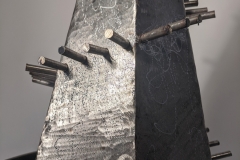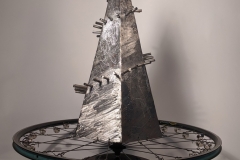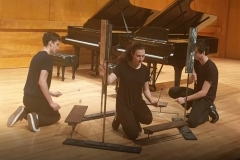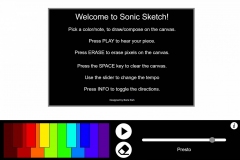Adviser: Ian Alan Paul
Introduction:
My senior thesis project was going to be Sonic Space, a solo gallery show in the Tabler Arts Center. I intended the show to be a collection of art pieces that were capable of producing sounds, with several steel and/or wood sculptures which could be played as percussive musical instruments, along with two creative coding projects. Unfortunately, the Coronavirus pandemic led to my show being cancelled, as well as leaving most of my sculptures trapped in the Staller Center basement until further notice. As such, I will use this document as a chance to describe my artistic practice, as well as provide descriptions for my documented pieces.
Artist’s Statement:
My first artistic inspirations came from math. In my mind, mathematics is almost holy, a beautifully intricate web, where pure ideas can connect in genuinely euphoric ways, existing only in the minds of those who understand it. The craftsmanship of mathematics is unrivaled. Every idea is rigorous, it can be demonstrably constructed out of a few bedrock axioms. And math seems fundamentally real and true. No matter who or where you are in the universe, when you draw a circle, π will inevitably pop up
As a sculptor, I am drawn to the mathematical forms found in Geometry and Topology, such as the platonic solids (the “basic building blocks” of three dimensional space), and repetitive/self-similar objects (fractals come to mind first). I am fascinated by how these forms seem natural and organic, despite coming from the platonic realm of mathematics. While much of math is inspired by natural observation, it exists in a realm separate from the physical. By creating forms which mimic nature, I create visual evidence of the deep connections between reality and math
I have no preferred sculptural medium, fabricating with wood and metal, casting in bronze (and occasionally chocolate), as well as incorporating found objects and electronic media. And as a digital artist, I often find that code allows me to express myself with mathematics, creating generative art that mathematically combines sound and color.
My other source of artistic inspiration comes from the world of contemporary percussion music. Unlike other classical instruments, classical percussion is an inherently modern practice, less than a hundred years old. And while most musicians only need to learn a single instrument (or a small handful of related instruments), percussionists must be generalists; our instruments include anything that makes a sound when you hit it. In my art practice, I combine sculpture and percussion by creating sonic sculptures; pieces which are simultaneously sculptures and musical instruments. These pieces are interactive, and are often coupled with musical performances.
Artwork Descriptions:
Modified Bicycle Wheel:
This piece was inspired by beFORe JOHN7, a percussion quartet which used the spokes of the bicycle wheel as an instrument. With this piece, I wanted to expand the sonic capabilities of a bicycle wheel, to include as many different sounds as possible. The most notable addition is the steel cone I fabricated and attached to the middle. I added short steel tubes up the cone in a spiral, which I can trigger with a metal rod to create a bright high-pitched “twinkling” sound effect. I also added jingle bells to the bottom spokes of the wheel, which are triggered by spinning the wheel back and forth. Finally, I include three implements to play the instrument, a metal triangle beater, a plastic brush-stick, and a playing card, which can either strike the bicycle wheel or be placed in the spokes as it rotates. This object functions as both a sculpture, and a musical instrument. Independent of interaction, it is still a visually striking object, and could very well be just a “regular” sculpture. And by putting all these sonic possibilities into the object, I make it interactive, allowing viewers to play with it.
MetalOnWood/WoodOnMetal:
My second sonic sculpture is MetalOnWood/WoodOnMetal. I would like to thank Olivia Gatto, Owen Lewars, and Kevin Vucinic, who you are about to see perform on this sculpture.
As you probably noticed, the two main sounds of this piece are wood and metal. Classical percussion music often divides its instruments into three groups of sounds: skins, metal, woods. I find that skins, which are usually synonymous with “drums” (including bongos, kick drums, and snare drums) are the most often recognized by non-musicians, so I wanted to make a piece which used the less common sounds, metal and wood.
What I find most interesting about this sculpture is its modular design. It is made out of six separate sub-modules, which fit together to create a hexagonal percussion set-up. There are two different instruments: pine planks and steel hollow-bars, each with three pitches: high, medium and low. The title of this piece comes from the construction of the modules. Each wooden plank is supported by steel bars, while each metal bell rests on top of plywood planks. The modular design makes transporting the piece much easier, while also allowing the piece to take up a lot of space when set up. In a gallery setting, I would place this piece in the center of the space, inviting gallery visitors to play outside or inside of the piece with others.
The next two pieces I want to talk about are creative coding website projects
These pieces share a similar theme, a synesthesiac connection between color and sound. Both of these phenomena exist as waves, either electromagnetic or acoustic. Our eyes associate different frequencies of light as different colors, and our ears associate different frequencies as notes. But while each color has only one frequency, the western musical system has a notion of “octaves”, where two sounds are the same note if their frequencies have the right ratio between them. For example, if you play a low C on a piano and then play the same C an octave higher, the frequency of the higher note will be twice as high as the lower note. And if you go another octave up, you get four times the frequency of the original note. You can keep doing this doubling octave thing as long as you want, until the frequency becomes too high to be transmitted by sound waves. But at that point, it can be thought of as an electromagnetic wave. And you go 40 octaves up, you can get the frequencies associated with visible light. In this way, you can map all 12 notes to their own distinct color, which I do in both my pieces.
https://boriskishinevsky.github.io/NagoyaMarimbas/
Nagoya Marimbas:
This piece is a Javascript loop, which takes Nagoya Marimbas, a piece by minimalist composer Steve Reich, and adds a minimalist visual element to it.
Nagoya Marimbas is a marimba duet, which I had the privilege to perform my sophomore year. In this piece, Steve Reich uses a technique called “phasing”. Each musician plays the same melodic and rhythmic line, but shifted to start at different times. This creates a distinct shifting melodic line, which harmonically evolves as the piece progresses. My piece splits the screen in half, and associates each half with one of the marimba players. Then, I translated the score into approximately 3,000 lines of Javascript if-statements, which triggered the right color to appear when it’s associated note was played.
https://boriskishinevsky.github.io/SonicSketch/
Sonic Sketch:
This website is interactive, and allows users to create their own drawings, and then turn those drawings into musical compositions. The color pallete is designed as a playable keyboard, which displays each note’s associated color. When the play button is pressed, the website turns the canvas into a score, reading each pixel (left to right, top to bottom) and playing the appropriate note on each color.
The first drawing-to-sound program was called UPIC, and was designed by composer Iannis Xenakis. As a side note, Xenakis is a super interesting guy. He’s famous in the very specific field of modern classical music, but pretty much unknown to most people. He wrote some of the first solos for percussion music, as well as a whole bunch of other stuff that I’m not gonna get into now. Anyway, UPIC allowed users to create line drawings, and then read them, with the vertical x-axis being pitch, and the horizontal y-axis representing time. My piece uses a different system to translate drawings to sounds, adding color to represent pitch (instead of height) and reading the picture pixel by pixel, instead of a horizontal scan.
I would say that the hardest part of this piece has been the web-development side. At the time of this recording, there are still several bugs in the code. The website doesn’t like being run on Apple devices, or Firefox browsers, and it’s unnecessarily difficult to figure out why and fix it.
Conclusion:
I would like to thank several people for helping me with this project. First comes, Ian Alan Paul, who was my faculty mentor, and is a huge inspiration and role-model to me. Dan Richolt, who gave me tons of advice and free steel while I was making my sculptures. And Paul St. Denis, who helped me turn Sonic Sketch into a functioning website. Lastly, I’d like to thank my parents for their financial and emotional support.









